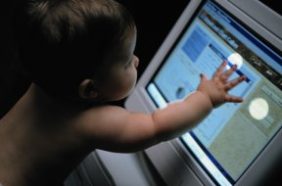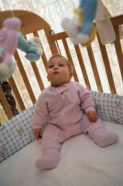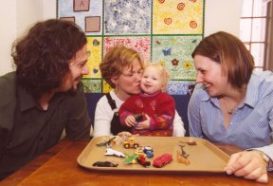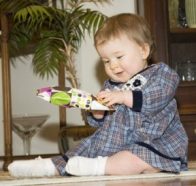How Much Babies Know
By studying how babies choose things, researchers have discovered that babies are especially good at learning things that are essential for survival.
By Emily Sohn
Babies can seem pretty helpless. They can’t talk or use a spoon properly. They can’t go to the bathroom by themselves.
A long time ago, you were a baby yourself. But you’ve made the transition from crying infant to independent kid. As you’ve grown, your brain has undergone major changes. As a result, you know the difference between a cow and a car, an orange and a tennis ball. You can read, spell, and do math.
 |
|
Are babies learning from the moment that they are born? |
For years, scientists have been intrigued by how a baby’s brain develops. They’ve been trying to figure out how and when babies become learning machines and begin to make sense of the world.
Some researchers suggest that babies start off early. “The ‘smart baby’ camp believes that babies learn quickly,” says David Rakison, a psychologist at Carnegie Mellon University in Pittsburgh. “They do math—[simple] addition and subtraction—within the first 6 months.”
Other researchers argue that babies take their time, slowly learning what they need to know.
Scientists who specialize in brain development do agree on one thing: The ways in which babies sort objects into groups is a key sign of brain development.
And after years of studying how babies sort toys and other objects, Rakison has concluded that babies are “smart” in some ways and “dumb” in others. Babies are particularly good, he says, at learning things that are essential for survival, such as recognizing faces or dangerous animals.
Clever strategies
Because babies can’t talk, researchers must design clever strategies to study them. “By constructing experiments carefully, we can learn a lot about what infants know,” says David Bjorklund, a psychologist at Florida Atlantic University in Boca Raton. “That’s very exciting stuff because it gives us a window into infant minds,” he adds.
 |
|
How a baby sorts objects can tell researchers something about how babies think. |
Careful study design is also especially important when working with babies because it’s easy to jump to wrong conclusions. For example, various studies have shown that babies tend to put toy cows and horses in one group and cars and planes in another. A researcher might be tempted to conclude that babies know what these objects really are.
Rakison, however, found that 14-month-olds also grouped chairs with cows, but kept both separate from vehicles. When he removed legs and wheels from the toys, babies put cows and cars in the same group.
“I became a cattle mutilator,” Rakison jokes.
 |
|
At Carnegie Mellon University’s Infant Cognition Lab, David Rakison (left) studies how babies process information and learn about the world around them. |
| Photo by Ken Andreyd; Carnegie Mellon University |
Rakison even put wheels on toy cows and legs on cars. Both 14- and 18-month-olds grouped legged cars together with legged animals. Babies, it seems, simply group objects by their parts. They don’t necessarily know what the objects are.
Learning and imitation
To better understand how babies learn, Rakison showed babies toy animals hopping up stairs and toy cars zooming around. Then, he gave the babies a chance to imitate his actions with a choice of objects.
“Eighteen-month-olds will hop anything,” Rakison says. By 22 months, they choose objects that make sense for the action. The key to learning, Rakison proposes, is imitation.
 |
|
Babies learn by imitation. |
| S. Norcross |
“Infants are learning how things move around in the world by watching their caretakers do actions and then deciding which things are like those objects, based on having the same parts,” Rakison says. “Then, they model the action.”
Young infants will learn nearly anything, Rakison says. As they get older, they become less likely to accept scenarios that don’t make sense—like cows with wheels or cars that hop.
Certain categories, however, may be so important that even very young infants learn them quickly. In his most recent experiments, Rakison showed spidery images to 5- and 9-month-olds.
The babies looked longer at realistic-looking spiders than at squished or scrambled spiderlike shapes. Babies as young as 10 months were also quicker to respond with fear to fake snakes and spiders than they were to cute stuffed rabbits, even when researchers acted as if they themselves feared the fluffy toys.
The results suggest that babies are born with some sense of what spiders and snakes are. “I’m not saying that they know [these animals are] bad or scary or dangerous,” Rakison says. “They’re simply prepared to learn.”
Danger signs
The idea that animals instinctively avoid dangerous situations is not new. For example, scientists know that fish born in captivity swim for cover when exposed to predators that they’ve never seen. Chimpanzees, likewise, learn quickly that spiders are scary—but it’s hard to persuade them that flowers are.
 |
| S. Norcross |
Rakison’s studies are among the first to show that human babies rapidly learn to be afraid of certain types of things, too. “This tells us,” Bjorklund says, “that our ancestors were ready to learn things that were ecologically relevant to the environment they grew up in.”
Learning more about how a baby’s brain develops might eventually help scientists understand what goes wrong in kids whose brains develop abnormally.
Babies do more than just eat, sleep, cry, and look around. “They really have something going on in their minds,” Bjorklund says.
“They’re making sense of the world in ways that we as speaking people have a hard time understanding,” he adds. “You should treat these little individuals with respect.”
Going Deeper:







